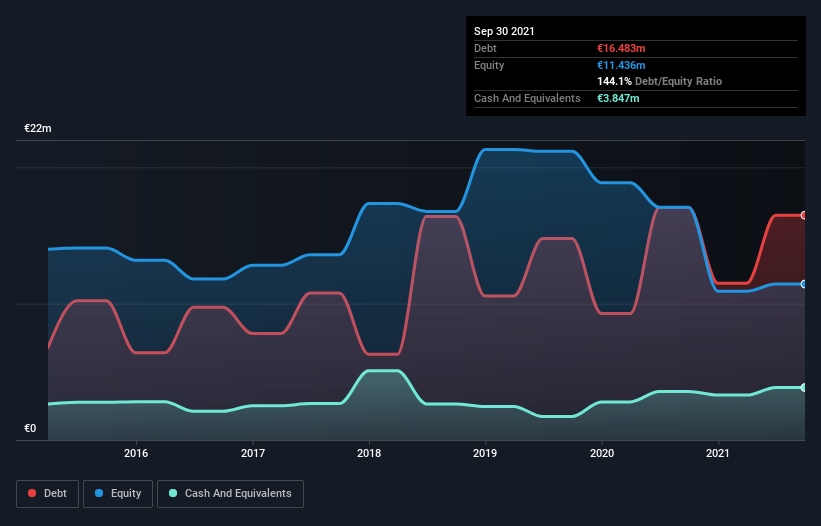Here's Why Prismaflex International (EPA:ALPRI) Has A Meaningful Debt Burden

David Iben put it well when he said, 'Volatility is not a risk we care about. What we care about is avoiding the permanent loss of capital.' So it seems the smart money knows that debt - which is usually involved in bankruptcies - is a very important factor, when you assess how risky a company is. We note that Prismaflex International, S.A. (EPA:ALPRI) does have debt on its balance sheet. But is this debt a concern to shareholders?
When Is Debt Dangerous?
Debt assists a business until the business has trouble paying it off, either with new capital or with free cash flow. If things get really bad, the lenders can take control of the business. While that is not too common, we often do see indebted companies permanently diluting shareholders because lenders force them to raise capital at a distressed price. Having said that, the most common situation is where a company manages its debt reasonably well - and to its own advantage. The first step when considering a company's debt levels is to consider its cash and debt together.
Check out our latest analysis for Prismaflex International
What Is Prismaflex International's Net Debt?
As you can see below, Prismaflex International had €16.5m of debt, at September 2021, which is about the same as the year before. You can click the chart for greater detail. On the flip side, it has €3.85m in cash leading to net debt of about €12.6m.

How Healthy Is Prismaflex International's Balance Sheet?
Zooming in on the latest balance sheet data, we can see that Prismaflex International had liabilities of €20.5m due within 12 months and liabilities of €11.9m due beyond that. On the other hand, it had cash of €3.85m and €9.29m worth of receivables due within a year. So it has liabilities totalling €19.2m more than its cash and near-term receivables, combined.
This deficit casts a shadow over the €12.4m company, like a colossus towering over mere mortals. So we definitely think shareholders need to watch this one closely. After all, Prismaflex International would likely require a major re-capitalisation if it had to pay its creditors today.
We measure a company's debt load relative to its earnings power by looking at its net debt divided by its earnings before interest, tax, depreciation, and amortization (EBITDA) and by calculating how easily its earnings before interest and tax (EBIT) cover its interest expense (interest cover). This way, we consider both the absolute quantum of the debt, as well as the interest rates paid on it.
Weak interest cover of 0.70 times and a disturbingly high net debt to EBITDA ratio of 15.5 hit our confidence in Prismaflex International like a one-two punch to the gut. The debt burden here is substantial. One redeeming factor for Prismaflex International is that it turned last year's EBIT loss into a gain of €195k, over the last twelve months. When analysing debt levels, the balance sheet is the obvious place to start. But it is Prismaflex International's earnings that will influence how the balance sheet holds up in the future. So when considering debt, it's definitely worth looking at the earnings trend. Click here for an interactive snapshot.
Finally, while the tax-man may adore accounting profits, lenders only accept cold hard cash. So it's worth checking how much of the earnings before interest and tax (EBIT) is backed by free cash flow. Over the last year, Prismaflex International actually produced more free cash flow than EBIT. That sort of strong cash generation warms our hearts like a puppy in a bumblebee suit.
Our View
To be frank both Prismaflex International's net debt to EBITDA and its track record of covering its interest expense with its EBIT make us rather uncomfortable with its debt levels. But at least it's pretty decent at converting EBIT to free cash flow; that's encouraging. Looking at the bigger picture, it seems clear to us that Prismaflex International's use of debt is creating risks for the company. If all goes well, that should boost returns, but on the flip side, the risk of permanent capital loss is elevated by the debt. The balance sheet is clearly the area to focus on when you are analysing debt. However, not all investment risk resides within the balance sheet - far from it. Be aware that Prismaflex International is showing 2 warning signs in our investment analysis , and 1 of those is a bit unpleasant...
If, after all that, you're more interested in a fast growing company with a rock-solid balance sheet, then check out our list of net cash growth stocks without delay.
New: Manage All Your Stock Portfolios in One Place
We've created the ultimate portfolio companion for stock investors, and it's free.
• Connect an unlimited number of Portfolios and see your total in one currency
• Be alerted to new Warning Signs or Risks via email or mobile
• Track the Fair Value of your stocks
Have feedback on this article? Concerned about the content? Get in touch with us directly. Alternatively, email editorial-team (at) simplywallst.com.
This article by Simply Wall St is general in nature. We provide commentary based on historical data and analyst forecasts only using an unbiased methodology and our articles are not intended to be financial advice. It does not constitute a recommendation to buy or sell any stock, and does not take account of your objectives, or your financial situation. We aim to bring you long-term focused analysis driven by fundamental data. Note that our analysis may not factor in the latest price-sensitive company announcements or qualitative material. Simply Wall St has no position in any stocks mentioned.
About ENXTPA:ALPRI
Prismaflex International
Designs, manufactures, and sells various advertising supports and wide format digital printing products and solutions worldwide.
Proven track record with mediocre balance sheet.
Market Insights
Community Narratives



